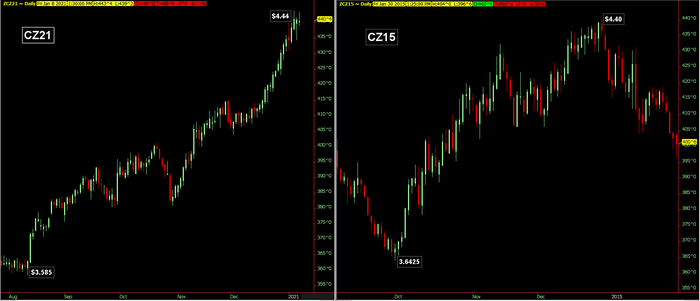
“I will tell you next week what you should have done this week.”
That is the story of our lives when dealing with the market.
Next week, though.
Next week we will get a USDA report that is really a series of several different reports. I am not even going to go into what reports they are because it really does not matter for what I have to say.
A ‘complete circus’
The events of the last few days, weeks, months and year have been a complete circus, domestically and internationally. We have seen this week how the actions of a few can impact the lives of so many. We saw this past year how the actions of one country can impact the rest of the world.
It all happens so fast. We cannot control what others do; we can control our own actions.
It is worth noting some price changes since the December WASDE report, to put things in perspective. March ’21 and Dec ’21 Corn settled +$0.75 and +$0.3125 respectively since the close the day of the December report, while March ’21 Soybeans and Nov ’21 Soybeans settled +$2.16 and +$1.1575 respectively.
The phrase “buy the rumor, sell the fact” should not be new to you and considering the change in values over the last month, it is obvious that corn and soybeans are vulnerable to this setup heading into next week’s data drop.
Expectations are, of course, for both corn and soybeans stocks to be reduced. Most expect to see exports bumped higher for both, while statistically there is a strong argument corn yield should also be reduced.
Now back to the part about controlling our own actions. Next week’s report will, no doubt, have a major impact on prices heading into spring. AgMarket.Net has been focusing lately on the month of February. The spring average for crop insurance guarantees will be set during the month of February, and you can take action to provide a worst-case scenario for those guarantees.
March Short Dated options are priced off the new crop contracts but will expire February 19th. Dec ’21 corn settled the week at $4.405; the March Short Dated 435 put has traded at 10 cents this week. This option provides a floor at $4.25 (4.35 - .10) during the month of February. The chart below of Dec ’21 corn compared to Dec ’15 should show numerous similarities.
Maybe those similarities end next week, but both contracts bottomed near $3.60 and rallied to $4.40 into year’s end. Notice that CZ15 started the month of February below $4. I am not saying that it will happen again, but it is proof it could.

Control your insurance floor
The bottom line is that you have the ability to control your insurance floor. As a producer, establishing a worst-case scenario for the month of February will allow you to be more patient with the marketing of your grain through the next several months to see what summer weather reveals.
Should 2021 evolve similarly to 2015, Dec ’21 corn beginning the month of February by trading below $4.00 will be much less of a concern with options in place.
This only works if you do it on all of your APH bushels, so either do it right or don’t do it at all.
If you are wondering what kind of level you can establish for soybeans, the 1130 put is 20 cents which will provide an $11.10 floor during the month of February.
If you feel this strategy is worth implementing, you better move quickly. The report will be released next Tuesday at 11 a.m. CST.
Feel free to contact me directly at 815-665-0463 or anyone on the AgMarket.Net team at 844-4AGMRKT.
The risk of loss in trading futures and/or options is substantial and each investor and/or trader must consider whether this is a suitable investment. AgMarket.Net is the Farm Division of John Stewart and Associates (JSA) based out of St Joe, MO and all futures and options trades are cleared through ADMIS in Chicago IL. This material has been prepared by an agent of JSA or a third party and is, or is in the nature of, a solicitation. By accepting this communication, you agree that you are an experienced user of the futures markets, capable of making independent trading decisions, and agree that you are not, and will not, rely solely on this communication in making trading decisions. Past performance, whether actual or indicated by simulated historical tests of strategies, is not indicative of future results. Trading infromation and advice is based on information taken from 3rd party sources that are believed to be reliable. We do not guarantee that such information is accurate or complete and it should not be relied upon as such. Trading advice reflects our good faith judgment at a specific time and is subject to change without notice. There is no guarantee that the advice we give will result in profitable trades. The services provided by JSA may not be available in all jurisdictions. It is possible that the country in which you are a resident prohibits us from opening and maintaining an account for you.
The opinions of the author are not necessarily those of Farm Futures or Farm Progress.
About the Author(s)
You May Also Like




